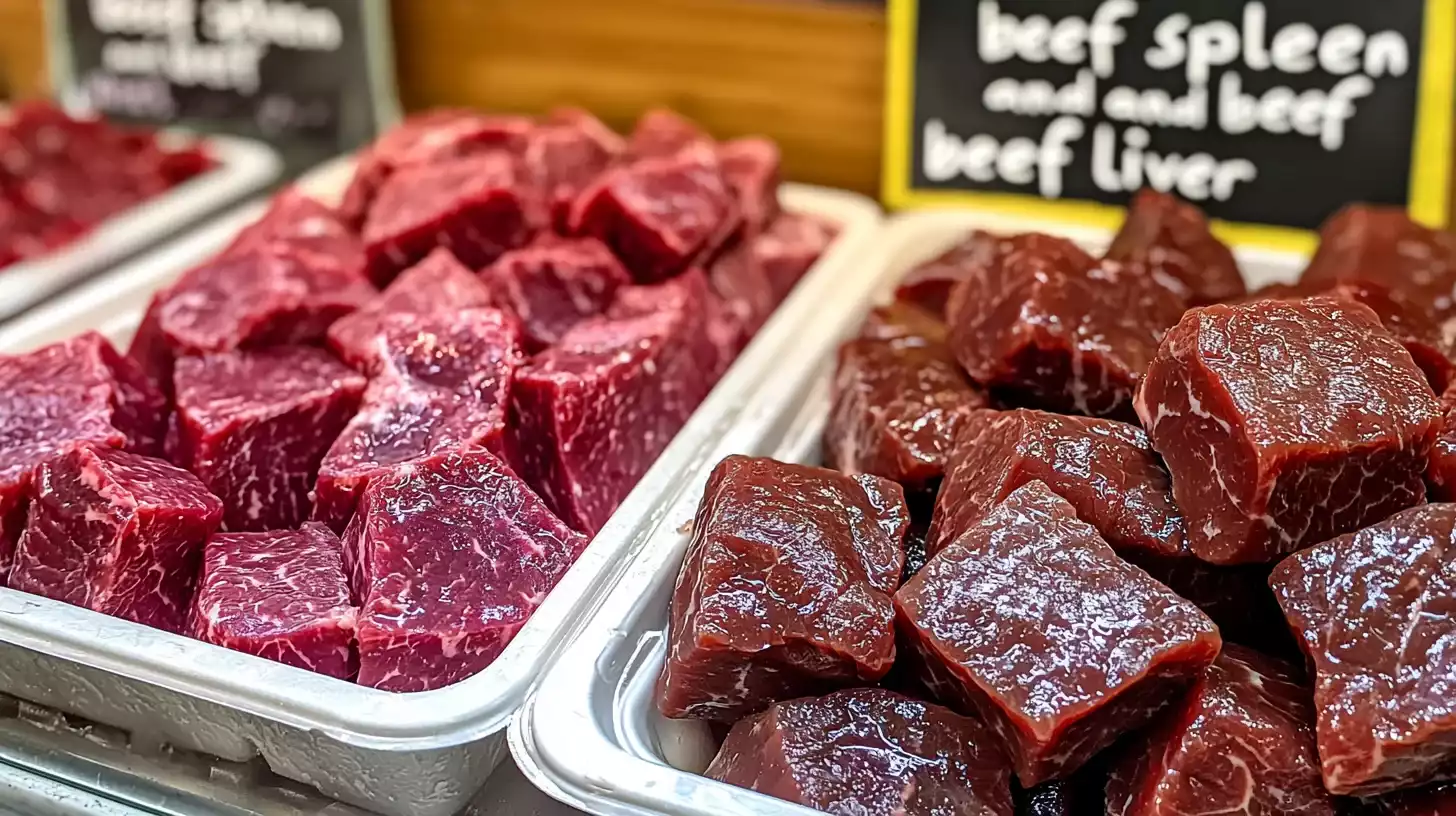Is beef spleen the same as beef liver? Beef offal, or organ meats, might not be the first thing that comes to mind when planning a meal, but these nutrient-dense foods are becoming increasingly popular. Among these, beef liver and beef spleen often cause confusion. Are they the same? Absolutely not! In this article, we’ll dive into the unique differences between beef spleen and beef liver, helping you understand their nutritional profiles, flavors, culinary applications, and which might be a better choice for your dietary needs. Discover 7 key differences between beef spleen and beef liver to make an informed decision.
Table of Contents
Understanding Beef Spleen
Beef spleen, often overlooked, is a dark red organ located near the stomach in cattle. Its primary function is to filter blood, removing old or damaged blood cells and playing a crucial role in the immune system. It’s a fascinating organ with a unique composition. Beef spleen has a smooth texture when raw and is generally a deep, reddish-brown color. Its texture is somewhat dense and slightly spongy.
Understanding Beef Liver
Beef liver, on the other hand, is a much larger organ located near the digestive system. The liver is responsible for many functions, including detoxifying the blood, producing bile for digestion, and storing vitamins and minerals. It is a vital part of the cow’s system. Beef liver has a smooth surface, a lobe-like structure, and is deep reddish-brown. Its raw texture is dense and firm, and slightly smoother than the spleen.
Is beef spleen the same as beef liver? Key Differences: Beef Spleen vs. Beef Liver
Let’s explore the key areas where beef spleen and beef liver differ significantly.

Nutritional Profiles
The nutritional profiles of beef spleen and beef liver are quite different, and these differences influence their health benefits and culinary uses.
- Vitamins: Beef liver is incredibly rich in Vitamin A, a crucial nutrient for vision, immune function, and cell growth. It also contains significant amounts of B vitamins, particularly B12, essential for nerve function and red blood cell production. Beef spleen, while it also contains B vitamins, is not as abundant in Vitamin A compared to beef liver. Both organs contain other essential vitamins like D, E and K, but their quantity in each differ greatly.
- Minerals: Beef liver is an exceptional source of iron, particularly heme iron, which is easily absorbed by the body. It’s also rich in copper and zinc, important for various enzymatic reactions and immune function. Beef spleen, however, is particularly rich in iron, even more than the liver, and offers a good source of zinc as well. It also contains other important minerals like selenium and phosphorus, albeit in varying quantities compared to the liver.
- Other Nutrients: Both organs are great sources of protein. Beef liver is higher in cholesterol and fat compared to beef spleen. Beef spleen generally has a more balanced fat content. The differences in their nutrient composition impact their taste and dietary benefits. This nutritional variety is one key reason why some people include organ meats in their diets.
Taste and Texture
The taste and texture differences are crucial when choosing between the two organs.
- Beef Liver: Beef liver has a strong, earthy, metallic flavor that some people find overpowering. However, its taste can vary depending on the animal’s diet. It has a smooth and somewhat dense texture when cooked, and it tends to become slightly softer if stewed or braised.
- Beef Spleen: In contrast, beef spleen has a milder, more subtle flavor, with a slight gaminess. Its texture is also more tender than the liver and slightly more spongy. The milder flavor of beef spleen can make it more approachable for those who find the taste of liver too intense. This difference in taste often drives culinary decisions.
Culinary Uses
Beef spleen and beef liver have very different culinary applications across various cultures.
- Beef Liver: Liver is often used in dishes such as pate, liver and onions, and liverwurst. It is often fried, braised, or ground into other mixtures. Its strong flavor is usually tempered with strong spices and aromatics. Some cultures also incorporate it into soups and stews for its nutritional value.
- To learn more about incorporating organ meats into your meals, check out our guide on [Top 10 Budget Friendly Meal Prep Tips]. It offers advice on making nutritious choices without breaking the bank.
- Beef Spleen: Beef spleen is less common in Western cuisine but more prominent in other global cuisines. It’s often found in stews, soups, and certain sausage varieties, especially in countries like Eastern Europe and parts of Asia. Its milder flavor means that it can be used more subtly to enrich a broth or add depth to a meal.
- For some inventive ideas on how to use offal in home cooking, our guide on [10 Unexpected Uses for Beef Bones in Your Kitchen] could offer some inspiration.
Availability and Price
Availability and cost are important considerations when choosing between these two offal options.
- Beef Liver: Beef liver is generally more readily available in most U.S. supermarkets and butcher shops, owing to its higher demand and popularity.
- Beef Spleen: Beef spleen is less common and might be harder to find in regular supermarkets. Often, it’s found at specialty butcher shops or international markets. As it’s less sought-after, it is often a lower price than liver.
- If you’re keen on exploring more options in offal, you could also check our article on [The Ultimate Guide to Beef Heart: Cooking Tips and Nutritional Benefits], this guide can enhance your experience and knowledge.
Health Benefits of Beef Spleen
Eating beef spleen has several health benefits. It’s a good source of iron, which helps prevent anemia and supports overall energy levels. The spleen also contains important minerals that are vital for the body’s immune system. However, like other organ meats, it should be consumed in moderation as part of a balanced diet.
- To help balance your diet, consider exploring [Delicious and Easy Ways to Prepare a Balanced Meal Every Night].
Health Benefits of Beef Liver
Beef liver is often called a “superfood” for its extremely high nutrient density. It is an excellent source of Vitamin A, iron, B vitamins, and copper. These nutrients are crucial for energy production, red blood cell formation, and maintaining healthy skin and vision. It also contains essential amino acids. Despite the nutritional benefits, it’s important not to overconsume liver, especially if you’re sensitive to high levels of Vitamin A or cholesterol. If you have questions about how offal fits into your dietary needs, you might consider discussing this topic with your doctor.
Choosing Between Beef Spleen and Beef Liver
The choice between beef spleen and beef liver depends largely on your dietary needs and preferences. If you require high iron levels, both organs are great, however, spleen might edge out as the best source. If you require high Vitamin A levels, liver is the superior choice. The flavor profile also influences your decision, with beef spleen offering a milder taste compared to the stronger flavor of beef liver. Your cultural preferences and availability might also be a key decider.
How to Prepare Beef Spleen and Beef Liver

Preparing these organs correctly is essential for a good culinary experience.
- Beef Spleen: Thoroughly clean the spleen under cold water and remove any connective tissue before cooking. Soaking the spleen in milk or water for a few hours helps to reduce the gaminess. It can be sliced, braised, or used in soups. Marinating the spleen can also enhance its flavor and tenderize the meat.
- For some simple preparation tips, our article on [The Ultimate Guide to Cooking Affordable, Delicious, and Simple Meals] can be a valuable resource.
- Beef Liver: Cleaning is also vital. Soaking the liver in milk helps to remove its bitter taste. Beef liver can be pan-fried with onions, braised, or used in pates. Slicing the liver thinly also helps to cook more evenly.
Where to Buy Beef Spleen and Beef Liver
Knowing where to find these organ meats can make your culinary journey easier.
- Beef Liver: Most well-stocked supermarkets and local butchers sell beef liver, either fresh or frozen. Check for signs of freshness: a good color, and avoid liver with an off smell or texture.
- Beef Spleen: You may need to look at specialty butchers or ethnic markets for beef spleen, as it’s not as common. Online retailers are also an option, offering these less readily available organ meats to customers across the US. When buying, check for signs of freshness and buy from a reputable seller.
- To get the best produce, consider our advice on [The Best Guide to Shop Groceries and Save Money].
FAQs
Here are some common questions regarding beef spleen and beef liver:
Is it healthy to eat beef spleen?
Yes, eating beef spleen can be part of a healthy, balanced diet. It is rich in iron and other vital minerals. However, moderation is key, as with any organ meat. If you have specific health concerns, it is best to consult with your doctor or a nutritionist.
Which part of the cow is spleen?
The spleen is located near the stomach in a cow. It is an organ that is part of the immune system and is crucial for filtering the blood and removing damaged blood cells.
What does beef spleen taste like?
Beef spleen has a mild, subtly gamey flavor, which is less intense than the strong taste of beef liver. Its texture is also more tender.
Conclusion
In conclusion, while both beef spleen and beef liver are nutritious organ meats, they are far from the same. They offer different nutritional benefits, have different tastes, and are used in a wide variety of dishes. The choice between the two will depend on your dietary needs, flavor preferences, and culinary creativity. Exploring both offers a way to enrich your diet with essential nutrients while expanding your culinary horizons. Why not try both and see which you like best? Leave a comment below and share your experiences.
For More Articles Links:

